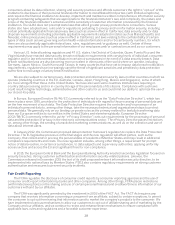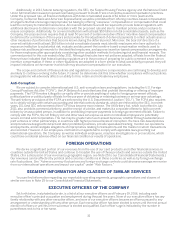American Express 2015 Annual Report Download - page 44
Download and view the complete annual report
Please find page 44 of the 2015 American Express annual report below. You can navigate through the pages in the report by either clicking on the pages listed below, or by using the keyword search tool below to find specific information within the annual report.
GUIDE 3 – STATISTICAL DISCLOSURE BY BANK HOLDING COMPANIES
You can find certain statistical disclosures required of bank holding companies starting on page A-1, which are
incorporated herein by reference.
ITEM 1A. RISK FACTORS
This section highlights specific risks that could affect us and our businesses. You should carefully consider each of the
following risks and all of the other information set forth in this Annual Report on Form 10-K. Based on the information
currently known to us, we believe the following information identifies the most significant risk factors affecting us.
However, the risks and uncertainties we face are not limited to those described below. Additional risks and uncertainties
not presently known to us or that we currently believe to be immaterial may also adversely affect our business.
If any of the following risks and uncertainties develop into actual events or if the circumstances described in the
risks and uncertainties occur or continue to occur, these events or circumstances could have a material adverse effect
on our business, financial condition or results of operations. These events could also have a negative effect on the
trading price of our securities.
Strategic, Business and Competitive Risks
Difficult economic conditions may materially adversely affect our business and results of operations.
Our results of operations are materially affected by economic conditions, both in the United States and elsewhere
around the world. Uncertain expectations for global economic growth have had, and may continue to have, an adverse
effect on us, in part because we are very dependent upon the level of consumer and business activity and the demand
for credit and payment products. A prolonged period of slow economic growth or deterioration in economic conditions
could change customer behaviors, including spending on our cards and the ability and willingness of Card Members to
pay amounts owed to us. Travel expenditures are sensitive to business and personal discretionary spending levels and
also tend to decline during general economic downturns. Further, economic instability in certain regions or countries
could negatively affect consumer and business spending in other parts of the world. If economic conditions were to
worsen, we could experience adverse effects on our results of operations and financial condition.
Factors such as consumer spending, business investment, government spending, interest rates, tax rates, fuel
and other energy costs, the volatility and strength of the capital markets, inflation and deflation all affect the economic
environment and, ultimately, our profitability. While the recent drop in oil prices may be beneficial for the U.S.
economy overall, it has negatively impacted, and may continue to negatively impact, the amount of gas spending on
our cards. An economic downturn characterized by higher unemployment, lower family income, lower consumer
spending, lower demand for credit, lower corporate earnings or lower business investment is likely to materially and
adversely affect our business, results of operations and financial condition. Furthermore, such factors may cause our
earnings, credit metrics and margins to fluctuate and diverge from expectations of analysts and investors, who may
have differing assumptions regarding their impact on our business, adversely affecting the trading price of our
common shares.
Our operating results may suffer because of substantial and increasingly intense competition worldwide in the
payments industry.
The payments industry is highly competitive, and we compete with a wide variety of financial payment products,
including charge, credit and debit card networks and issuers, paper-based transactions (e.g., cash and checks), bank
transfer models (e.g., wire transfers and ACH), as well as evolving alternative payment mechanisms, systems and
products, such as aggregators and web-based payment platforms (e.g., PayPal, Square and Amazon), wireless
payment technologies (including using mobile telephone networks to carry out transactions), virtual currencies,
prepaid systems, gift cards, mobile payments, blockchain and similar distributed ledger technologies, and other
systems linked to payment cards or that provide payment solutions. We also compete with technology companies,
telecommunication providers, handset manufacturers, large retailers and retailer coalitions that are seeking to
integrate more financial services into their product offerings.
We are the fourth largest general-purpose card network on a global basis based on purchase volume, behind
China UnionPay, Visa and MasterCard and. We believe Visa and MasterCard are larger than we are in most countries.
As a result, competitive card issuers and acquirers on the Visa and MasterCard networks may be able to benefit from
the dominant position, scale, resources, marketing and pricing of Visa and MasterCard.
Some of our competitors have developed, or may develop, substantially greater financial and other resources than
we have, including larger cash reserves, may offer a wider range of programs and services than we offer or may use
more effective advertising, marketing or cross-selling strategies to achieve broader brand recognition, cobrand card
33
























